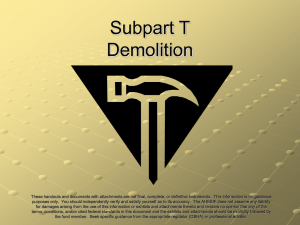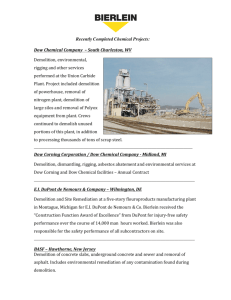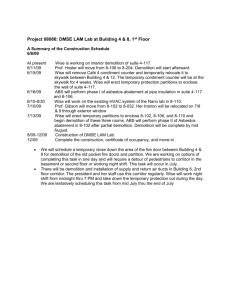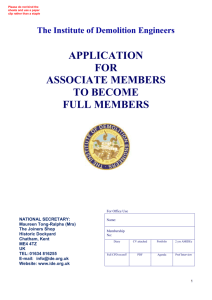Case study template
advertisement
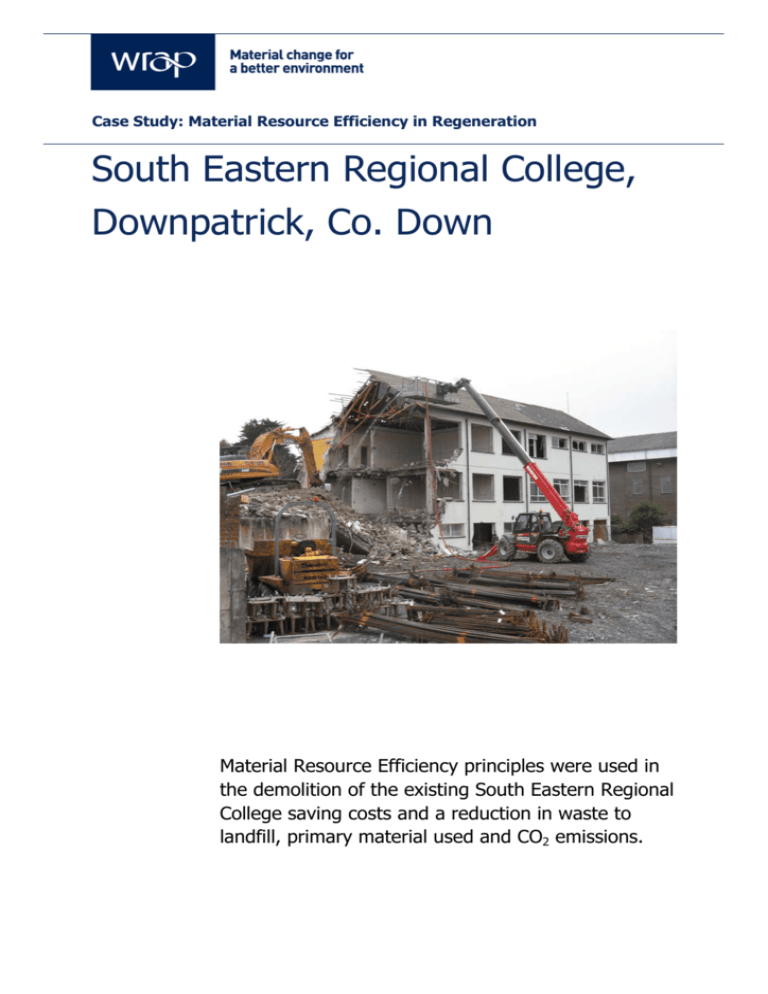
Case Study: Material Resource Efficiency in Regeneration South Eastern Regional College, Downpatrick, Co. Down Material Resource Efficiency principles were used in the demolition of the existing South Eastern Regional College saving costs and a reduction in waste to landfill, primary material used and CO2 emissions. 1 Summary WRAP’s (Waste & Resources Action Programme) Materials Resource Efficiency (MRE) principles and approach in regeneration projects is outlined in the WRAP Regeneration Guide 1 . This guide contains best practice guidance for policy makers, clients, consultants and contractors alike and is intended for use by each of these groups at demolition and new build construction phase as well as at the interim phases through on site reclamation and recycling of materials. This case study is an example of how the principles in the guide were applied at demolition and construction stages of the new £17 million second phase campus for the South Eastern Regional College, Downpatrick, Co. Down in 2009. McCormack Demolition were contracted by O’Hare & McGovern, the main contractor, to provide demolition services within their replacement school build programme at the South Eastern Regional College School, Co. Down. This case study outlines the approach McCormack’s and the wider construction team used in order to maximise the reuse and quantity of recyclable materials in the project. The demolition programme was carried out within a compact urban site and within a tight overall construction project programme. McCormack Demolition achieved total savings of £165,149 and 95.7 tonnes CO2 through diverting materials from landfill and reducing the project requirement for primary aggregates when compared against standard practice. These savings flowed from a targeted programme of site segregation and through the production of site-won recycled aggregates, matching the materials generated by the demolition process with the construction requirements of the main contractor. 1 http://www.wrap.org.uk/construction/tools_and_guidance/regeneration.html 2 1. Key project facts McCormack Demolition were contracted by O’Hare & McGovern to provide demolition services within their replacement school build programme at the South Eastern Regional College School, Co. Down. This case study outlines the approach McCormack’s and the wider construction team used to maximise site-won and recyclable materials. The demolition programme was carried out within a compact urban site and within a tight overall construction project programme. The £60 million redevelopment of South Eastern Regional College campuses in Lisburn, Downpatrick, Ballynahinch and Newcastle have been progressed as a Public Private Partnership with the private sector consortium responsible for design, build, finance and operation over a 25-year period. O’Hare & McGovern were commissioned to provide the new campus at Downpatrick and it is the £17 million, second phase of the development that is the subject of this case study. This phase will add space to facilitate workshops, central hall, media suite, general classrooms and car parking facilities. Upon completion of the initial new build phase, the existing college building was able to be demolished. McCormack Demolition was required to complete demolition works between April and September 2009 to ensure the overall build programme was achieved. The initial phase of the contract involved asbestos removal and soft strip of the school premises. This was followed by the demolition of the main school building and subsequent materials reprocessing. This case study summarises the reuse and recycling activities of the demolition works. 3 2. Best practice tools There are a number of support tools that establish best practice techniques for materials resource efficiency. This case study links the actions taken by the construction and demolition team to these best practice guidelines. 2.1. Materials Resource Efficiency (MRE) The efficient use of materials can lead to time and cost savings, an increase in reuse and recycling of materials, reduction in materials sent to landfill, primary resources used (e.g. virgin aggregate) and carbon emissions. The Materials Resource Efficiency (MRE) approach as advocated in the WRAP guide “The efficient use of materials in regeneration projects 2 ” provides a framework for all relevant stakeholders (policy maker, development client, designers, demolition contractors, new build contractors and project managers). A combined approach from all the stakeholders will maximise project opportunities. 2.2. Quality Protocol McCormack Demolition has in the last year developed a Quality Protocol Management System that meets the requirements of the WRAP Quality Protocol for the production of recycled aggregate from inert materials. 3 This has meant that the company has been able to crush materials on site to produce a product that has been reused on site or made available for use off site. This has diverted considerable amounts of aggregate materials from landfill sites and has played a key role in increasing the recycling rates 2 3 http://www.wrap.org.uk/construction/tools_and_guidance/regeneration.html http://aggregain.wrap.org.uk/quality/quality_protocols/ 4 that McCormack Demolition have achieved in the various contracts they have delivered in the last year. 2.3. Site Waste Management Plans As of August 2010, Site Waste Management Plans (SWMPs) are not a legal requirement in Northern Ireland, but have been adopted since 2006 as procurement best practice by the Sustainable Construction Group for public sector contracts over £200,000 or requiring a workforce of over 50. SWMPs are an important tool in designing out and managing wastes through the life of a construction programme and are being actively promoted by regulators and the construction sector as best practice. Successful implementation of SWMPs can demonstrate a company’s ability to enhanced sustainability and aid in winning contracts. O Hare & McGovern had implemented a SWMP 4 for the overall project and as such McCormack Demolition were required to provide project waste arisings information. A SWMP was not developed for the demolition works specifically; however, McCormack Demolition maintained detailed weekly records of how much demolition material was produced, recycled and where it was sent. 2.4. ICE Demolition Protocol, 2008 The protocol outlines best practice techniques for each of the key stages for the contractors and project designers through demolition and new build phases. 5 4 For more information on Site Waste Management Plans refer to http://www.wrap.org.uk/construction/tools_and_guidance/site_waste_manage ment_planning/index.html (Accessed 21 July 2010) 5 http://www.ice.org.uk/Information-resources/Document-Library/DemolitionProtocol-2008 5 3. Planning for Materials Resource Efficiency (MRE) Good planning is essential to optimise material resource efficiency during the demolition and construction phases. As part of the project set up, the following areas were considered: contract framework and programme; types and Quantities of Materials arising; types and Quantities of Materials required in Development; demolition techniques and equipment; site layout (opportunities and constraints); available waste management infrastructure; and monitoring and Reporting requirements. 3.1. Contract framework and programme The contract tender documentation gave McCormack Demolition freedom to carry out the project in an efficient manner. The overall contract between O’Hare & Mc Govern and their Client (Lisburn Education Partnership) also incorporated sustainability clauses. The South Eastern Regional College (SERC) is the end user for the building. The demolition works were on the critical path for the redevelopment project. In order to facilitate the maximum recovery and on site recycling of material it is important to ensure that the project phasing allows sufficient time for material testing for recycled aggregates following processing. 3.2. Types and quantities of materials arising A high level audit was carried out by McCormack Demolition as part of the tender bid preparation in order to provide an initial list of the types and quantities of materials that would be produced 6 through the demolition contract. This was further refined on contract award. The materials identified included: concrete masonry and mixed masonry; brick/ Rubble; timber; metal; plasterboard; and asbestos. A pre-demolition audit is a key tool in linking the demolition and regeneration phase and when carried out at an early stage identifies in greater detail the quantities of material that will be generated and integrating planning for material reuse on site, recycling and disposal more fully. 3.3. Types and quantities of materials required The use of site-won materials was primarily related to concurrent construction activities including a need for aggregate to form a temporary development platform for the next stage of the construction programme. This material was subsequently reclaimed and sent off site for reuse. With further planning this material could have been used by the site contractor within the build programme for any number of general purposes. This would also have had additional benefits of CO2 avoidance through reduced transport and production of virgin aggregates in addition to saved costs of virgin aggregates. Given that McCormack Demolition were unfamiliar with the local recycled aggregate market in the site’s locality an advertisement was taken out in a local newspaper in order to identify an off site market for the materials produced. The response to the advertisement was encouraging and the interest in the materials outstripped the available product, although it should be noted that 7 in the current market climate, the main value gained was through the avoidance of landfill taxes and gate fees. 3.4. Demolition techniques and equipment The demolition works were carried out adjacent to a busy leisure centre, residences and traffic therefore special measures were required including some out of hours working. The demolition contract involved a Type 3 Asbestos survey and subsequent removal of hazardous materials from the building prior to soft strip and demolition. Asbestos was removed from the buildings outside of the main school term to minimise health and safety risks. McCormack Demolition carried out the soft strip of materials within the building by machine and hand prior to commencing demolition of the structure. The building was cleared on a room by room basis, with each room being checked before being sealed to prevent re-entry ahead of the demolition works. As the intention was to recover aggregate, there was a particular focus on ensuring the soft strip was rigorous to reduce contamination. Structural demolition of the buildings was carried out using specialist demolition rigs fitted as required with steel shears, clam shell style grabs and concrete munchers. The systematic deconstruction of the building made provision for the safe and controlled demolition of the structure and the effective management of potential environmental nuisances such as dust, noise and vibration. It was also the basis for a systematic identification and separation of material for reuse and recycling. On site crushing and screening was carried out using an Extec C12+ mobile unit under a Pollution Prevention Control (PPC) 8 permit. The material produced met the specification for a general use sub-base type material (Class 1c Coarse Granular). Demolition being completed on a room by room basis 3.5. Site layout (opportunities and constraints) The layout of the site was such that there was sufficient space for the crusher/ screener and associated stockpiles; this is not always the case. In negotiation with O’Hare & McGovern a suitable location was agreed for the screening, crushing, quarantine and stockpile activities. Once the materials were tested to confirm they met the relevant BS Standard they were moved for use on site or off site to ensure that the product stockpiles did not impinge on crushing and quarantine space availability. The materials were crushed on site using a suitably licensed machine, regulated by Down District Council, the local authority, in this case. There was no requirement to register the site as a waste management facility as materials were not being imported. 9 3.6. Available waste management infrastructure Due to the tight time constraints on the project, similar to most demolition projects, the only feasible option was for the soft strip materials including timber and plasterboard to be collected and sent to a nearby recycling facility (approximately 20 mile round trip). McCormack Demolition carried out the haulage to the facility and paid a gate fee charge for the materials deposited. The recycling facility then had the responsibility of separating the waste for recyclable and reusable components. 3.7. Monitoring and reporting requirements McCormack’s measured the amount of recycled aggregate and material sent off site for re-processing using a delivery note and log book system, which also supported their internal project management needs. Recycled aggregate product was provided to external contractors at no cost, excluding haulage. The size of the lorry container and average aggregate weight were used to determine volumes leaving the site. An alternative method would have been to measure the dimensions of the product stockpiles; however given the need to remove materials off site quickly McCormack’s determined the first method was more appropriate for this project. McCormack’s, through the development of an in house environmental and quality management system, have been monitoring the demolition recovery index for selected projects in order to set internal targets by demolition project. This has been done primarily through the analysis of demolition and wastes arising post demolition from consignment and transfer notes. This information can also be fed back into their client’s overall Site Waste Management Plan. 10 4. Recovery, reuse and recycling rates By measuring key data, a comparison can be made with best practice indicators and targets set for future projects. Demolition arisings data were derived from transfer consignment notes and site logs. All information is stated in tonnes unless otherwise indicated. Table 4.1: Demolition data and KPI’s Recovered items Concrete / mixed masonry Plasterboard Quantity arising Recovery (%) Recovered on site Recovered off site Tonnage disposed - 55 9,063 99% 9,008 24 100% - 24 - 7 100% - 7 - Metal 875 100% - 875 Mixed waste 320 0% - Timber Totals - 0 320 9,008 906 375 Tonnage recovered for use on site (Q1) Tonnage recovered for use off site (Q2) Tonnage disposed (Q3) Demolition Recovery Index (DRI) (Q1+Q2) / (Q1+Q2+Q3) 96.2% Retained Material (RM) Q1 / (Q1 +Q2) 93.9% 11 5. MRE practice benefits In order to quantify the economic and environmental benefits of adopting materials resource efficiency on site, three scenarios have been developed for comparison. Scenario A shows the cost and impact if all material went to landfill. Scenario B is an example of fairly standard practice and Scenario C is good practice, demonstrating what was done on this project. Table 5.1: MRE scenarios Scenario 6 Landfill Off site recovery On site recovery - - A Concrete/ Mixed masonry Plasterboard 6 Timber Misc rubble Metal Mixed waste B Misc rubble Mixed waste Concrete/ Mixed masonry Plasterboard Timber Metal C Misc rubble Mixed waste Plasterboard Timber Metal Concrete/ Mixed masonry There are currently no suitably licensed cells that can accept plasterboard waste in Northern Ireland 12 5.1. Project costs and savings A summary of indicative cost and carbon savings and impacts associated with its use is presented below in Table 5.2. Table 5.2: Summary of project savings. Scenario A Materials disposed (£) Materials imported (£) Materials off site CO2 Materials imported CO2 B C £254,379 £184,159 £81,165 £62,155 £62,155 £0 29.9 t 28.5 t 18.8 t 86.0 t 86.0 t 0.0 t TOTAL COST £316,534 £246,314 £81,165 Total CO2 115.9 t 114.5 t 18.8 t £70,220 1.4 t £235,368 97.1 t £165,149 95.7 t Savings compared to Scenario A Savings compared to Scenario B Table 5.2 shows that an overall cost saving of £235,368 is achieved by recovering and recycling materials on site where practicable when compared to all materials being sent off site to landfill and an equivalent tonnage of aggregate materials being imported. A more realistic saving is when compared to scenario B which shows a cost saving of £165 149 when some material streams are recovered for use on site. In addition, using site-won recycled aggregate instead of imported primary aggregate results in an avoidance of 95.7 tonnes of CO2. Written by Kathryn Tims and David Hay, EnviroCentre Limited The Authors wishes to thank the following for their contribution in developing this case study: Mc Cormack Demolition, O’Hare and Mc Govern and Department of Employment and Learning. While steps have been taken to ensure its accuracy, WRAP and EnviroCentre cannot accept responsibility or be held liable to any person for loss or damage arising out of or in connection with this information being inaccurate, incomplete or misleading. This material is copyrighted. It may be reproduced free of charge subject to the material being accurate and not used in a misleading context. The source of the material must be identified and the copyright status acknowledged. This material must not be used to endorse or used to suggest WRAP’s endorsement of a commercial product or service. For more detail, please refer to our Terms & Conditions on our website: www.wrap.org.uk www.wrap.org.uk/construction


